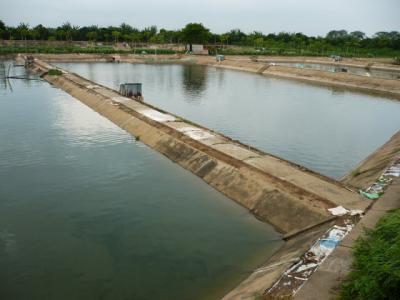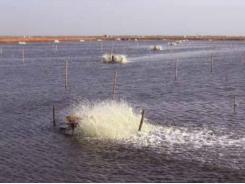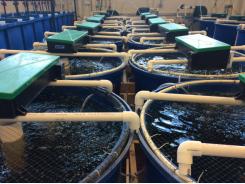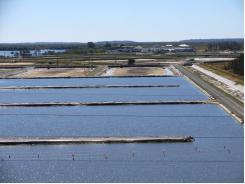Waste Removal Methodologies

Wastes must first be removed from the culture water and then disposed of in an environmentally benign manner, or preferably, in a profitable manner. In the overview of the waste removal methods below it will be assumed that removal of the wastes from the water is separate from disposal unless it is noted in the text that the process being discussed combines the two functions.
Mechanical Solids Removal Systems
Settling/ Sedimentation: Settling depends on the difference in density between particles in the water and the water. The greater the density differences the faster separation can be achieved. Solids in aquaculture systems typically have a specific gravity of about 1.19 (Chen et al., 1993) hence the driving sedimentation forces are a specific gravity difference of about 0.19. Typically, retention times for settling basins used in aquaculture range from 15 to 60 minutes. Recirculating system designers most commonly use a 15 to 20 minute retention times for waste. A well designed sedimentation tank will usually remove most particles down to less than 100 microns. Sedimentation basins are simple, have nomoving parts, but do require labor to maintain and/or clean out the settled solids.
Sand filters: Fixed bed sand and particle bed filters may be used in aquacultural applications but are not widely used in commercial systems. These filters consist of a box filled with sand or some other particulate material. Water is allowed to pass through the fixed bed either in a downward direction (down flow) or in a upward direction (up flow). Particles are removed from the water as it is “screened” by the sand filter. Particles are removed fromsomeminimum size and larger. Theminimum particle size removed depends on the sand size, flowrate and waste characteristics. Sand filters can be designed to remove particles down to about 30 microns (Wheaton, 1977). The smaller the filter media particle size is the smaller the waste particles that are removed. However, clogging, back wash frequency, and head loss increase with decreasing filter media size. Sand filters work well on clear water, but suffer the need for frequent back wash intervals or excessive head loss if the waste stream is very concentrated. Gravity and vacuum sand filters are rarely used in aquacultural systems, while pressure sand filters may be found on low technology systems.
Screens: Screens remove particles the same size or larger than the mesh size of the screen. Screens come in a wide variety of configurations and each has its advantages and disadvantages. Stationary screens are rarely used in aquacultural systems because they plug rapidly and require too much costly labor and maintenance to maintain and operate. Occasionally tangential screens, a type of self cleaning stationary screen, are employed in small aquacultural recirculating systems.
Drum screens are used frequently in aquacultural production systems for solids removal. These are rotary screens, often referred to as microscreens in sewage treatment, that are continuously back washed. Hence the continuous or intermitten automatic backwash prevents the rotating screen fromplugging. These units are simple, but have severalmoving parts and require a backwash pump. The screen costs vary with capacity but typically are in the range of $4,000 to $5,000 for a 750 to 1100 liter per minute unit. Flow rate is a function of the screen mesh used, characteristics of the wastes, water flow and waste concentration. Typical aquacultural applications use 60 to 100 micron screens.
Bead Filters: There are several types of bead filters. Themost common type contains plastic beads that are typically 3 to 5 mm in diameter. The beads may be approximately spherical or they may have other shapes. The beads are formed from some type of plastic having a specific gravity close to that of water, usually slightly less than water so they float. There is a screen in the top and in the bottomof the filter. Water pumped fromthe bottomupward through the filter causes the beads to be held against the upper screen as long as the water keeps flowing. The water passes through the filter which acts like a screen to remove the particles that are larger than the openings between the beads. As the bead bed becomes clogged with solids, the filter is backwashed by stopping the water flow and either mechanically stirring the beads to remove the solids so they can settle to the bottom of the tank or by removing the water from the beads and causing the bead bed to break up into individual beads thereby releasing the solids. The solids are then flushed out of the tank and the water flow restarted to put the filter back into operation (Beecher et al., 2001). This filter also will operate as a biofilter (see biofilters below).
Other configurations of bead filters include filters that use 1 to 2 mm diameter foam beads that obviously float in place of the beads described above. There are other filters that are designed such that the water flow causes the beads to rise in the center of the filter and circulate downward around the outside of the filter. This last configuration is essentially self cleaning except the bottom of the tank has to be flushed out periodically.
Diatomaceous Earth Filters: Diatomaceous Earth (D. E.) filters are essentially very fine particulate filters although their principles of operation vary somewhat froma typical fixed bed sand filter. Diatomaceous earth filters will remove particulates down to about 0.1 microns (Purchas, 1967). Unfortunately, diatomaceous filters are relatively difficult to use, they plug easily, and typically require considerable labor. Thus, they are used where crystal clear water is needed such as in aquariums where water transparency is highly important. Because commercial aquaculture systems do not require crystal clear water, D. E. filtration is seldom used due to the additional cost required.
Centrifuges andHydroclones: Typically centrifuges are cylindrical in shape. The cylinder rotates as water is allowed into the bottom of one end of the cylinder. Cylinder rotation is very rapid, sometimes several hundred thousand revolutions perminute, which creates very high acceleration forces in the water passing through it. The particles in the water, being slightly more dense than the water, move to the outside of the cylinder and the clean water toward the center of the cylinder. Thus, by taking a very thin layer ofmaterial off just inside of the cylinder wall, most of the particles are removed. Clean water then exits from the center of the cylinder. In aquaculture the particles usually are notmuchmore dense than the water. The advantage of centrifuges is that the acceleration in the centrifuge can be adjusted by selection of the tube diameter and rotational speedwhile the percentage ofwater removed with the waste can be adjusted by selection of the depth of water collected on the inner wall of the centrifuge. Centrifuges are not widely used in commercial aquaculture because they are expensive to purchase and operate and they require considerable maintenance.
Hydroclones are similar to centrifuges in that they generate high acceleration forces that aid separating solids from the water. Hydroclones consist of a cylindrical and a conical section. Water under pressure enters the top of the vertical cylindrical section tangentially and is forced to rotate in the cylindrical section. As the water circulates, cylindrical forces cause the particles to move outward toward the cylindrical case. Gravity pulls the circulating water downward into the conical section of the hydroclone. Somewater fromalong thewall of the hydroclone is allowed to drop out of the bottomof the hydroclone (underflow) taking most of the particles with it. Because the inflow is greater than the underflow, the clean water in the center of the hydroclone rises and exits from the top of the hydroclone (overflow). The smallest particle size removed is a function of the water pressure, density difference between particles and water, percent of underflow and other variables. Hydroclones are occasionally used in commercial aquaculture, primarily for small systems. Hydroclones have no moving parts so they are reliable, but they have a significant proportion of the water in the underflow with the particles. They also require at least 30 to 60 psi pressure drop across the hydroclone, an energy expensive requirement.
Chemical Filters
Chemical filters are used primarily for removal of dissolved materials or very fine particulates. Typical these filters rely on chemical reactions to adsorb materials from the water, e.g. carbon adsorption and foam fractionation. The second attraction is electrical, with one compound (the one be removed from the water) having a greater binding ability than a species already bound to the substrate, e.g. ion exchange.
Adsorption: There are many materials that can be used as an adsorption matrix including activitated carbon, compost, wood bark and other materials. Activitated carbon is most widely used because it has a very high surface area per unit volume (sometimes as high as 1 to 2.5 x10^6 m2 /kg) (EPA, 1973). Activitated carbon will also adsorb a wide variety of chemicals on its surface. Aquacultural use of carbon adsorption is limited to uses requiring crystal clearwater or in emergencies for absorbing certain chemicals that accidently got into the aquaculture system. Cost, labor requirements, rapid plugging, and disposal of used carbon are a few of the reasons it is not widely used in aquaculture.
Foam Fractionation: Foamfractionation depends on adsorption of dissolved and very fine particulates onto bubble surfaces. A simple foam fractionator is simply an air stone in the bottom of a vertical pipe. As bubbles from the air stone rise through the pipe they collect dissolved materials from the bulk liquid onto their surfaces. Because of the chemistry, the pollutant concentrates on the bubble surfaces in excess of the concentration it is found in the bulk liquid. When the bubbles reach the surface the bubbles are removed and the excess concentration is removed with it. Foam fractionation is widely used in aquaculture. It is simple, inexpensive, and is one of the few ways of removing dissolved pollutants from fish culture water. Additional theoretical discussion of foam fractionation can be found in Wheaton (1977) and Timmons (1994).
Ion Exchange: Ion exchange is a method of removing dissolved materials from the water. Typically it consists of a packed bed of ion exchange media, typically small spheres of material 1 to 2 mm in diameter. The ion exchange has an electrical charge on its surface caused by the adherence of charged particles. Aswatermoves through the packed bed, ions in the water are exchanged for ions that are attached to the media. The most familiar ion exchange system is the softening of water where sodium is bound onto the ion exchange media. Water containing calcium flows over themedia and the surface of themedia attracts the calcium more strongly than the sodium. Thus, the media gives up sodium and adsorbs calcium. The systems is recharged by running a very high concentration of sodium through the filter. Because the sodium concentration is very high, it displaces the calcium with the sodium, thereby recharging the ion exchange media. The characteristic of ion exchange is that it adsorbs one or more ions and it gives off one or more ions. There is always a net charge of zero exchanged. If calcium is released (valence of 2), two sodium are adsorbed (each with a valence of one). Thus, the net charge on the ion exchangemedium remains the same. Whether or not the ion released is toxic must be considered. It is also obvious that the ion exchangemedia has a certain capacity, i.e amount of ion it will adsorb per unit mass of media before it must be recharged. The water used to recharge the ion exchange media may or may not be caustic, acidic or have some other characteristic that makes disposal of it difficult.
Ion exchange medium may be a natural product (e.g. Clinoloptile) or a man made material. It can be manufactured to selectively adsorb specific ions, e.g. ammonia. Ammonia adsorption is probably the most common use of ion exchange in aquacultural systems. Because it is an ion exchange system and salt water has very high ion concentrations, ion exchange will not work in salt or most brackish water systems. It works well in fresh water systems, but there is concern about the cost as ion exchangemedia is quite expensive. There are many variables that effect the efficiency or removal of specific ions by ion exchange media. Thus, the design of these systems is often somewhat specific to the waste water characteristics.
Biological Filters
There aremany types of biological filters (or biofilters) used in aquaculture and wastewater treatment systems. Conversion of ammonia to nitrite and then to nitrate is probably themost common biofilter used in aquaculture. However, there are biofilters used for removal of BOD (Biochemical Oxygen Demand), nitrate (an anaerobic system), and other uses. Here the focus will be on biofilters that remove ammonia and convert it to nitrite and then to nitrate Ammonia is toxic to fish in the range of 1 ppm (part per million), nitrite is toxic in the 1 to 2 ppm range while fish can often tolerate over 1000 ppm of nitrate. Toxic levels of these three nitrogen compounds depend on temperature, pH, fish health, ion concentration in the water, and other factors. However, the point here is ammonia and nitrite are much more toxic at the same concentrations than is nitrate.
Ammonia is produced in aquacultural systems by direct excretion from the fish and by breakdown of organic compounds by heterotrophic bacteria as the first inorganic compound produced Via the nitrogen cycle, ammonia is then oxidized to nitrite (NO2 ) by several bacterial species, the most commonly known genus of which is Nitrosomonas. Nitrite is then further oxidized by several groups of bacteria, the most widely known of which is Nitrobacter, to nitrate (NO3). The rate at which the conversion of ammonia to nitrate takes place is dependent on nitrogen concentration in the water, the oxygen concentration, the organic concentration in the water in the filter, temperature, and other variables. How big a biofilter you must have on the recirculating systems depends on these same variables plus others such as the completeness of cover of the fixed media by nitrifying bacteria, the surface area of the filter per unit volume, and others. Although anyone can build a biofilter, designing an efficient one is a rather difficult job and is one best left to experts in filter design.
Biological filters come in a variety of physical configurations. The oldest types are fixed bed designs with the water flowing from the top to the bottom (downflow) or from the bottom upward (upflow). The bed can be most any material that is not toxic to the fish or the bacteria (e.g. oyster shells, sand, rocks, mesh material, etc.). It is desirable to have a high surface area per unit volume as this leads to smaller filters for the same job. However, smaller diameter filter media, through it has a high surface area to volume ratio, easier to plug and it has to be back washed more often.
Bead Biofilters: Bead filters were described above under solids filters. Exactly the same filter can also be used as a biofilter. The plastic media must be treated slightly more gently during backwash so all of the bacteria are not removed from the beads but otherwise the filters are the same. Bacteria grow in the plastic beads in the filter and use ammonia and/or nitrite as a food source and thereby remove it fromthewater. These filters are quite efficient as they have a high surface area to volume ratio, but the beads are not so small that they plug excessively. These filters are commercially available in a variety of sizes and designs.
Fluidized Sand Biofilters: Fluidized sand filters are widely used in aquacultural applications for biofiltration because they have a very high surface area to volume ratio, and hence produce a relatively small footprint for the ammonia removal they achieve.Essentially a fluidized sand filter is a tank about half full ofwashed, graded sand. Water is pumped into the bottom of the tank at an increasing velocity. At some flow rate the sand begins to boil and it becomes fluidized. Fluidizing the sand makes all surfaces of the sand particles available for bacteria to growon. Because the surface area to volume is high, fluidized sand filters are take up a relatively small space for the ammonia removal rate they can produce. They are reliable if operated properly, relatively inexpensive, and if properly designed, relatively easy to operate.
Other Biofilter Designs: There are hundreds of configurations for biofilters. Each has their advantages and disadvantages. Ideally a good biofilter will not plug or will have to be back washed only infrequently, it will be reliable (will not break down or the bacteria will not die off for no apparent reason), it is inexpensive to install and operate and it takes up as little floor space a possible. It must remove the ammonia and nitrite down to acceptable levels and keep them there as soon as it is broken in.
Summary
Fish produce waste, waste pollutes the culture water, which in turn requires filter systems to remove the pollutants prior to recirculating the water. Waste production is a function of the feed fed, and the more feed fed the greater amount of waste must be removed whether or not the fish consume the feed. There aremany types of filters available to remove wastes from fish culture systems. The most common filters employed include particulate (mechanical) filters, chemical filters, and/or biological filters. The types of filters used depends on the culture systems, owner’s preferences, loading rates, fish species, and other variables.
Waste Removal Principles
There are some general principles that need to be followed in waste systems or recirculating systemdesign. First, themore quicklywastes are removed fromthewater the less time they have to break down and the less oxygen they will demand from the culture system. The longer the waste particles are in the culture system the smaller they become, due to mechanical damage from passing through pumps and plumbing and bacterial degradation.
The smaller the particles and the closer the particle density is towater, themore difficult the particles are to remove from the culture system. Particles also leach into the water and create dissolved wastes that are difficult to remove. Rapid removal of particulate wastes from recirculating systems is of upmost importance.
Secondly, wastes from aquatic production systems include ammonia, nitrite, nitrate, phosphorus (primarily phosphate), solids, and an array of organic compoundswhich inmost systems are completely unidentified. For example, recirculating aquaculture production systems exhibit brown or coffee colored water. Some of the coloring compounds are tannins, but there are a host of compounds that have not been studied. It is known, for example, that ozone will break down these color compounds, but the nature of these compounds and/or the breakdown compounds formed during ozonation are not known. It is not presently understood whether or not it is necessary or desirable to remove these compounds from the culture water. Ammonia, nitrite, nitrate, and phosphorus typically are dissolved compounds and will require a biofilter, chemicalmethod, or ion exchange system to remove them. Solids can be removed by mechanical filtration.
Thirdly, stocking density often is a primary determinate in the profitability of a recirculating system. Higher stocking densities and more rapid growth rates allow more weight of fish to be produced fromthe same physical facility. This in turn spreads capital costs overmore units (kgs of fish) thereby lowering the capital cost attributed to each kg of fish. However, increasing stocking densities require better management, and more reliable systems and systems components. The waste loads are higher and waste removal from the system and waste disposal after it is removed from the system become increasingly critical problems. Eventually a point is reachedwhere further stocking density increases do not increase profit. Because the most profitable stocking density will depend on many variables, it is not yet well defined for recirculating systems.
Related news
Tools

Phối trộn thức ăn chăn nuôi

Pha dung dịch thủy canh

Định mức cho tôm ăn

Phối trộn phân bón NPK

Xác định tỷ lệ tôm sống

Chuyển đổi đơn vị phân bón

Xác định công suất sục khí

Chuyển đổi đơn vị tôm

Tính diện tích nhà kính

Tính thể tích ao




 How will climate change impact seafood production?
How will climate change impact seafood production?  Water quality and Water quality Management in Aquaculture
Water quality and Water quality Management in Aquaculture